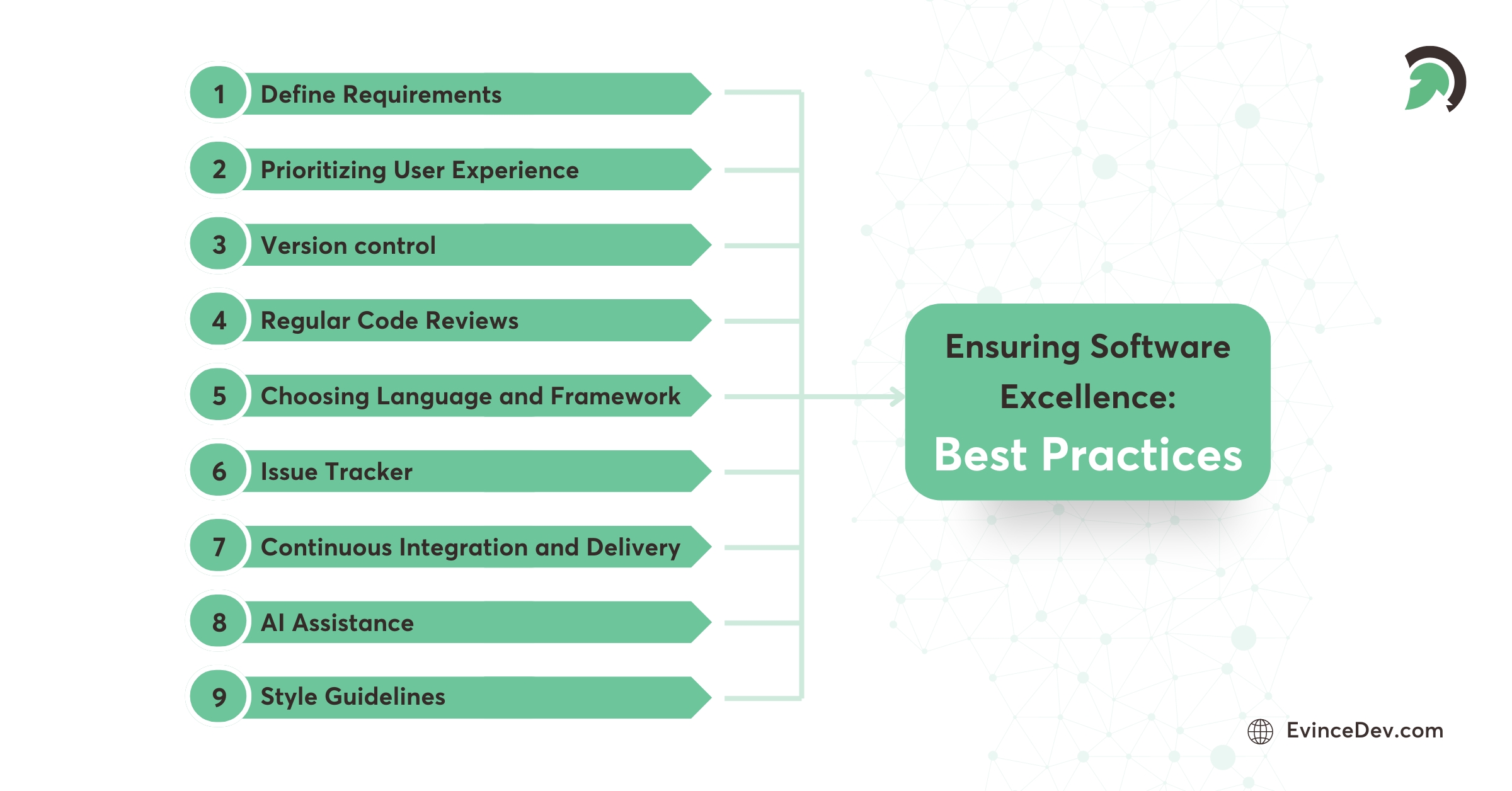Software development plays a crucial role in today’s technology-driven world. It encompasses the process of designing, coding, testing, and maintaining software applications. To ensure successful software development, it is essential to follow best practices and adhere to key principles. This article will explore various aspects of software development and provide valuable insights into the top practices that can enhance efficiency, maintain quality, and deliver exceptional software products.
Understanding Software Development
The basics of software development involve developing computer programs that execute specific tasks or functions. It encompasses a range of activities, including requirement analysis, design, coding, testing, deployment, and maintenance. Software developers utilize programming languages, frameworks, and tools to achieve the desired functionality.
Software development is crucial in enabling organizations to create innovative solutions, streamline processes, and enhance productivity. Additionally, it contributes to the digital transformation of industries, making them more efficient and competitive in the market.
Basics of Software Development
In software development, the initial step is to gather requirements from stakeholders. This involves understanding the goals, objectives, and desired outcomes of the software. Once the requirements are clear, the development team moves on to the design phase. Here, they create the software architecture, define the components, and establish the overall structure.
After the design is finalized, the coding phase begins. Software developers write code based on the design specifications. This code is then tested to identify and fix any bugs or issues. Finally, the software is deployed and maintained to ensure its continuous operation and improvement.
Importance of Software Development in Today’s World
In a society that heavily relies on technology, software development plays a critical role in fulfilling the ever-growing demands of businesses and consumers. Software applications are used in various domains, including healthcare, finance, e-commerce, and entertainment.
- Automation: Software automates routine tasks, freeing up human resources for more complex and strategic work. This leads to increased efficiency, productivity, and cost savings.
- Innovation: Software development is at the forefront of technological innovation, driving the creation of new products, services, and business models. From artificial intelligence to virtual reality, software powers groundbreaking advancements.
- Connectivity: Software enables seamless connectivity between people, devices, and systems. This has revolutionized communication, collaboration, and access to information, fostering a more interconnected world.
- Problem Solving: Software can be used to solve complex problems across a wide range of industries. From healthcare to finance, software applications are developed to address specific challenges and improve outcomes.
- Personalization: Software enables personalized experiences, tailoring content and services to individual preferences and needs. This enhances user satisfaction, loyalty, and engagement.
- Accessibility: Software can be designed to make information and services accessible to people with disabilities. This promotes inclusivity and ensures that everyone can participate fully in society.
Key Principles of Software Development
The following key principles can significantly impact the success of software development projects:
Agile Methodology
The Agile methodology emphasizes collaboration, adaptability, and iterative development. It promotes frequent communication between the development team and stakeholders, allowing for continuous feedback and refinement of requirements. Agile practices, such as sprints and daily stand-up meetings, enable efficient project management and faster delivery of software products.
One of the key aspects of Agile methodology is its focus on responding to change over following a plan. This flexibility allows teams to adapt to evolving requirements and market conditions, ensuring that the delivered software meets users’ needs effectively. By breaking down the development process into smaller, manageable increments, Agile helps mitigate risks and deliver value incrementally.
DevOps Approach
DevOps is an approach that aims to bridge the gap between development and operations. It promotes the integration of development, testing, and deployment processes, enabling smooth and continuous software delivery. By automating tasks, using version control systems, and implementing continuous integration and continuous delivery (CI/CD) pipelines, organizations can achieve faster release cycles and improved collaboration among teams.
It encourages a culture of shared responsibility and accountability across development and operations teams. This cultural shift fosters better communication, transparency, and collaboration, leading to higher-quality software releases and improved overall efficiency. By breaking down silos and encouraging cross-functional collaboration, DevOps helps in streamlining the software delivery pipeline and reducing bottlenecks that can hinder the speed and quality of releases.
Best Practices for Efficient Software Development
The following practices contribute to efficient software development:
Define Requirements Clearly
Defining requirements is a fundamental practice in efficient software development. It involves thoroughly understanding and documenting the project’s goals, features, and functionalities before coding begins.
Clear requirements serve as a blueprint, guiding the development process and helping to prevent scope creep, miscommunications, and project delays. By ensuring that all stakeholders, business analysts, customers, and the development team are aligned on the expectations from the outset, teams can avoid costly revisions and rework later in the project.
It also improves the accuracy of project estimates, allowing for better planning and resource allocation. Ultimately, well-defined requirements pave the way for a smoother development process and a successful software product.
Prioritizing User Experience
Developers should focus on creating software that provides exceptional user experiences. This involves understanding user needs, designing intuitive interfaces, and ensuring smooth navigation. Conducting usability tests and gathering user feedback can help identify areas for improvement and enhance overall user satisfaction.
Incorporating user-centered design principles, such as creating personas and user journey maps, can guide developers in tailoring software features to meet specific user requirements. By empathizing with end users and considering their perspectives throughout the development process, software teams can deliver products that resonate with their target audience.
Version control
Version control is critical to efficient software development, ensuring that code changes are tracked, managed, and documented throughout the project lifecycle. In version control tools like Git, teams can maintain a history of code revisions, allowing them to roll back to previous versions quickly if necessary.
This practice fosters collaboration, allowing multiple developers to work on different parts of the codebase simultaneously without conflicts. It also supports continuous integration by facilitating the merging of code changes into a shared repository. Version control enhances the overall stability and quality of the software by providing a structured way to manage and review code updates, track bugs, and ensure that the latest codebase is always secure and functional. CVS, SVN, and Mercurial are also widely used version control systems.
Regular Code Reviews
Code reviews are essential for catching errors, improving code quality, and promoting knowledge sharing among team members. By conducting regular code reviews, software development teams can identify potential issues, optimize performance, and ensure compliance with best coding practices.
In addition to identifying bugs and enhancing code readability, code reviews also serve as valuable learning opportunities for team members. Through constructive feedback and collaborative discussions during code review sessions, developers can expand their knowledge, share best practices, and collectively elevate the quality of the codebase.
# Create a new branch for your featuregit checkout -b feature/new-feature
# Add your code changes
git add .
# Commit your changes
git commit -m “Implement new feature”
# Push the branch to the remote repository
git push origin feature/new-feature
# Create a pull request for code review
Choosing the Ideal Language and Framework for the Project
The languages, platforms, and architecture you choose are hard to adjust later, so choosing wisely at the beginning is vital.
Utilizing frameworks is fundamental in efficient software development, as they provide a structured approach to building applications. Frameworks offer pre-built components, libraries, and tools that simplify the development process, enabling developers to focus on implementing unique features rather than reinventing the wheel.
It often comes with built-in support for standard functionalities such as authentication, data handling, and UI elements, which reduces the need for repetitive coding and minimizes errors.
Frameworks facilitate scalability and maintainability by promoting a modular design and standardized code structure. Its organized approach helps teams manage complex projects more effectively, making it easier to collaborate and update software over time. Offering a foundational skeleton for your application, frameworks enable you to incorporate your code efficiently. This reduces the need to create essential functionalities from scratch and supports consistency across diverse platforms.
Issue Tracker
The Issue tracker helps prioritize tasks, bugs, and feature requests throughout the development cycle. By documenting and tracking issues systematically, teams can ensure that every concern is addressed promptly and nothing is overlooked. It facilitates clear communication among team members and stakeholders, providing a centralized location for discussing and resolving issues.
Issue tracker can integrate with other development tools, such as version control systems and project management software, creating a cohesive workflow.
It helps maintain transparency and accountability, as developers can easily see which issues are associated with code changes or project milestones. Utilizing an issue tracker streamlines the process of managing and resolving issues and supports continuous improvement by allowing teams to review past issues and learn from them.
Continuous Integration and Continuous Delivery
Implementing CI/CD pipelines facilitates seamless integration of code changes and streamlines the software delivery process. Automation of testing, building, and deployment activities minimizes errors, reduces manual effort, and enables faster, more reliable releases.
Moreover, adopting a DevOps culture that emphasizes collaboration between development and operations teams can further enhance the efficiency of CI/CD pipelines. By breaking down silos, fostering communication, and promoting shared responsibility for software delivery, organizations can accelerate time-to-market, improve product quality, and respond more effectively to changing market demands.
pipeline { agent any
stages {
stage(‘Build’) {
steps {
sh ‘npm install’
sh ‘npm run build’
}
}
stage(‘Test’) {
steps {
sh ‘npm test’
}
}
stage(‘Deploy’) {
steps {
sh ‘npm run deploy’
}
}
}
}
Embrace AI Assistance
Leveraging AI tools in software development is becoming increasingly vital for improving efficiency and quality. One such example is GitHub Copilot, an AI-powered code completion tool created by OpenAI and GitHub. It boosts efficiency by offering real-time code suggestions to engineers. AI tools can automate a variety of repetitive tasks, such as code generation, bug detection, and testing, freeing up developers to focus on more strategic and creative aspects of their work.
AI can also aid in predictive analytics, helping teams anticipate project timelines and resource requirements more accurately. It allows for better planning and prioritization, ultimately leading to faster delivery of high-quality software products. AI-driven chatbots and virtual assistants can provide real-time support and guidance to developers, answering questions and offering solutions to common problems.
Adhere to Style Guides
It is crucial in software development to ensure the entire team follows a consistent coding style. This consistency makes the code more readable and maintainable, reducing the likelihood of errors and misunderstandings during code reviews. Style guides also promote collaboration, as they set clear writing and formatting code standards, enabling developers to work more efficiently together.
Role of Testing in Software Development
Testing is a crucial component of the software development lifecycle. It ensures that the software functions as intended, meets quality standards, and provides a stable and reliable experience to end-users.
Effective testing not only helps in identifying and fixing bugs but also contributes to enhancing the overall user experience. By conducting thorough testing, developers can gain insights into how users interact with the software, leading to improvements in usability and performance.
Importance of Automated Testing
Automated testing allows for faster and more efficient testing of software applications. It helps identify bugs, regression issues, and performance bottlenecks early in the development cycle, reducing the time and resources required for manual testing. Automated testing frameworks and tools enable developers to create robust test cases and perform comprehensive test coverage.
Furthermore, automated testing plays a vital role in continuous integration and continuous delivery (CI/CD) pipelines. By automating the testing process, developers can ensure that new code changes do not introduce unexpected issues and can be seamlessly integrated into the existing codebase.
Different Types of Testing in Software Development
Software development involves various types of testing to ensure the quality of the application:
- Unit Testing: It focuses on testing individual components or units of code to ensure their functionality. Additionally, Assess the extent of code covered by unit tests using code coverage tools, emphasizing any areas that require more scrutinity. Istanbul, CodeCover, and Parasoft Jtest are a few well-liked tools.
- Integration Testing: This type of testing verifies the interaction and integration between different modules or components of the software.
- Performance Testing: It evaluates the performance, scalability, and stability of the software under different load conditions.
Other types of testing, such as security, usability, and compatibility testing are also essential to address specific aspects of software quality. Security testing helps identify vulnerabilities and ensure the software is secure from potential cyber threats. Usability testing focuses on the user interface and overall user experience, while compatibility testing ensures that the software functions correctly across different devices and platforms.
Maintaining Quality in Software Development
To maintain quality throughout the software development process, the following practices are crucial:
Importance of Documentation
Documentation plays a vital role in software development. It helps understand the system’s architecture, design decisions, and implementation details. Detailed documentation facilitates future maintenance, collaboration among team members, and onboarding of new developers.
Moreover, comprehensive documentation is a reference point for stakeholders, including project managers, quality assurance teams, and clients. It ensures everyone involved in the software development process is aligned with the project’s goals, requirements, and progress. Additionally, documentation can aid in troubleshooting issues, tracking changes, and providing insights into the evolution of the software over time.
Code Refactoring and Its Benefits
Code refactoring involves restructuring existing code without changing its functionality. It helps improve code readability, maintainability, and performance. Software developers can enhance code quality and reduce technical debt by removing duplicate code, eliminating unnecessary complexity, and following coding best practices.
Furthermore, code refactoring promotes a culture of continuous improvement within development teams. It encourages developers to review and enhance their code regularly, leading to increased efficiency, better collaboration, and a more robust codebase. Embracing code refactoring as a standard practice results in higher-quality software and fosters a sense of pride and ownership among team members.
Final Thought
By following these software development best practices, organizations can streamline their development processes, deliver high-quality software products, and meet the evolving demands of users. Efficient software development boosts productivity and contributes to businesses’ overall success and growth in today’s competitive digital landscape.
EvinceDev emphasizes compliance with set standards and practices, from managing environments to code reviews and unit tests. If our methods appeal to you, explore our software development services offerings.








